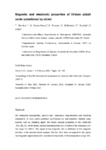Magnetic and electronic properties of lithium cobalt oxide substituted by nickel

Use this link to cite
http://hdl.handle.net/2183/14034Collections
- Investigación (FCIE) [1235]
Metadata
Show full item recordTitle
Magnetic and electronic properties of lithium cobalt oxide substituted by nickelDate
2003-02Citation
Gendron F, Castro-Garcia S, Popova E, Ziolkiewicz S, Soulette F, Julien C. Magnetic and electronic properties of lithium cobalt oxide substituted by nickel. Solid State Ionics. 2003;157(1-4):125-32
Abstract
[Abstract] We measured susceptibility, electron-spin resonance, magnetization and electrical conductivity of LiCo1−yNiyO2 powders synthesized by wet-chemistry method using succinic acid as chelating agent. We found unusual properties in the nickel-rich LiCo0.2Ni0.8O2, which shows several resonance lines as a function of the temperature in the range 3.5–300 K. The signal at low magnetic field is attributed to the magnetic domains in the nanostructured sample. The two other lines correspond to the typical ferromagnetic signal observed in powdered compounds. In the temperature range 120–300 K, the unique ESR line centered at 315 mT is the paramagnetic signal with a gyromagnetic factor g=2.12, which is in good agreement with the presence of a high concentration of Ni3+ (3d7) ions. In the nickel-rich oxide, LiNi0.8Co0.2O2, the magnetic data are qualitatively well-described by the model proposed by Drillon and Panissod for a 3D ferromagnetic order.
Keywords
Electron-spin resonance
Ferromagnetic order
Wet-chemistry
Ferromagnetic order
Wet-chemistry
Editor version
ISSN
0167-2738





